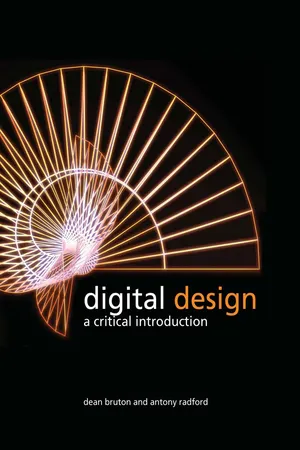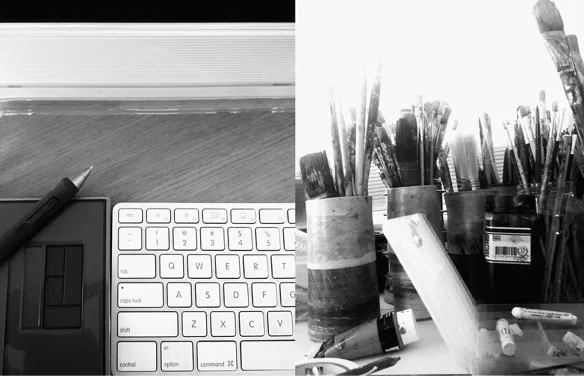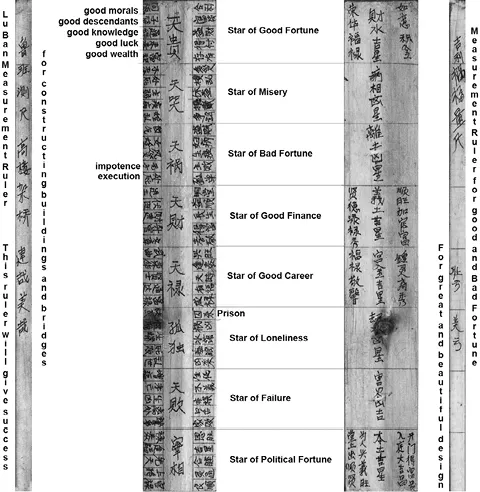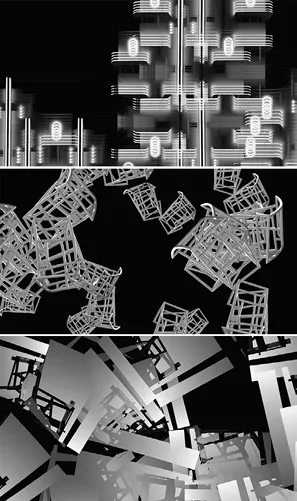chapter 1
rules and digital design
This chapter introduces our approach to digital design and designing through rules, pattern and contingency and the idea of designs as part of a language with a vocabulary. We explore how digital representation and computation facilitate an approach to digital design that emphasizes these ideas.
what are the rules in digital design?
This book is a critical introduction to thinking and working in digital design. We explore design with, by or for digital media in any visual field including designed environments (such as architecture and urban design), art, industrial design, film and interactive visual games. We span these many visual fields because a group of core concepts apply to all of them. The purpose of this book is to present this coherent theoretical framework and demonstrate its value to digital designers.
what is digital design?
Digital design is simply design with digital media. Design with digital media is the use of digital processes, graphics and modelling to generate, represent, analyse, evaluate and store design descriptions. Since the 1990s, with the advent of desktop publishing, digital design has largely usurped the use of traditional design media.
design production changes
The design product might be digital or physical. With the Internet, digital radio and television, in today’s world perhaps more designing is done for virtual domains than for the physical world.1 Where the design product is physical, production is increasingly automated by the direct use of computer aided manufacturing (CAM).
Figure 1.1 Electronic pens and tablets join brushes in the designer’s tool kit as digital design changes the traditional design and visual arts studio.
Defining Digital Design
Digital design is the use of computers in the creation of artefacts. The nature of designing has changed since computers began to be used in the process of conceptualization and representation of the design development. Digital drawings and models are immediately editable in ways that are not easily available to traditional media. As William J. Mitchell in City of Bits foresaw, ‘the uncertainties and dangers of the bitsphere frontier are great, but it is a place of new opportunity and hope’ (1995: 173).
Figure 1.2 Rules are found in natural phenomena, as in the way branches and leaves in this plant follow consistent rules that distinguish it from others. Comparable rules can be found in design. Courtesy of Dean Bruton.
a critical introduction
This critical introduction to digital design points out limitations and dangers as well as advantages of thinking and working with digital media. We are both enabled and limited by any media. We will emphasize the roles of rules and patterns and show that digital design empowers designers in their use of rules and patterns for design production. Furthermore, we will illustrate how rules and patterns pervade all digital designing; even when designers are not seeking to impose rules, the media will subtly do so.2
Digital design empowers a designer’s use of rules and patterns, but even when a designer is not seeking to impose rules, the media will do so.
Any critical introduction includes analysis, identification and explanation. We will explain how digital design has compelling advantages, but designers who use it can struggle to cope with what appears to be outside the rules of its software systems. We will see how we need to recognize, welcome and exploit the unexpected, and that thinking in terms of systems and rules is not incompatible with intuition and creativity. The extensive examples from various design disciplines show how the ideas in this book can be genuinely helpful to designers.
In life, the rules that have been imposed on us, and those that we have developed ourselves, are adapted to the special circumstances of each moment. The fact that we are constantly following rules does not mean that we are doomed to follow the same rules in the same way.3
We need to see rules as things to be interpreted freely and to see contingency or the chance occurrences of nature as opportunities for creative change and innovative adaption to circumstances.
what is a rule?
A rule is a way things inevitably happen (as in the rules of physics and nature), or the way things are obliged to happen (as in the rules of games and law), or just the way in which things tend to happen (as in the unwritten rules of a style of art or architecture). We find rules operating everywhere in the world. The uncanny reality of computer simulations reflects the observation and digital representation of rules found in natural phenomena: the ways that creatures move, trees grow,4 light reflects, water ripples and rock fractures. We shall see that comparable rules mark the products of human design.
Figure 1.3 Lu Ban Ruler replica (on top), compared to a modern standard ruler. Courtesy of Dean Bruton.
Figure 1.4 Lu Ban Ruler surfaces showing translated ancient cultural associations for particular measurements, origin c.450 BC. Courtesy of Dean Bruton.
rules and patterns and digital design
A pattern is a set of rules. The rules may not be spelled out in words but they are implicit in the pattern. Software routinely includes patterns (alternatively called templates) that provide a starting point for adaptation by a designer.
It is tempting to scoff at these preestablished patterns as undermining the creativity of designers, but designers follow a long tradition of using templates or patterns as starting points for designs. Medieval book illustrators kept pattern books with examples of elaborate page decorations, early equivalents of word processing templates. Carpenters used wood or steel stencils that could be drawn around to define a shape. Tailors used paper patterns to cut cloth for a garment’s components. All these patterns could be adapted to suit particular circumstances. Design in the digital age is still guided by patterns.
A word processing template, then, embodies rules for margins, fonts, page format and colours. A carpenter’s stencil embodies rules for the shape that will be cut if the stencil outline is followed. But the pattern may not encompass all the rules that define our design. Equally, the pattern may include rules that do not fit in our design.
Figure 1.5 Traditional wooden gulou (meeting hall) in Shanjiang, China, built with the Lu Ban style rule system. Courtesy of Dean Bruton.
Figure 1.6 Stills from Chronograph by Tal Rosner and C.E.B. Reas (2011), a dynamic digital mural projected on the wall of the New World Centre, Miami, USA. Courtesy of Casey Reas and Tal Rosner.
In every aspect of life, we tend to start doing whatever it is by following a pattern we have seen or experienced before and then adapting the pattern to suit the situation. It is as if there is a rule that in this situation we use that pattern.
In the early ambitious days of artificial intelligence, rule-based frames and scripts were written to formalize such patterns, so that what we do intuitively could be emulated by computers. But of course, days and situations are not identical. We adapt the pattern to suit the circumstances. While encoding the rules in frames and scripts was relatively easy, recognizing when they apply and how they need to be adapted was and can still be difficult.
In digital design, some of these patterns are drawn directly from precedents in the field of design in which we are engaged. If we are designing something, we look at precedents: if we are designing a Web site, we look for precedents in other Web sites; if we are designing a tap, we look at precedents of other taps.
Architects find patterns in space and construction handbooks, graphic designers in the established styles of fonts, page layouts and image formats. These are precedents, too. They share the characteristic of being whole or partial solutions, pointing to possible ways of doing things (Alexander et al. 1977).
In digital design, we might take a pattern for a Web site from a book, a tree or a river, as well as from another Web site. We might take a pattern for a digital game from a physical sport, a board game or a phenomenon in life that is not usually regarded as a game. Everything we see around us is a potential pattern for our work. If we look at the world with eyes that see patterns, we will build up our own storehouse of unusual patterns that might be relevant for our future designs.
We will see that taking a pattern from one field and using it in another field is one kind of creative action.
This is not mere imitation. Mature designers use multiple patterns that are overlaid and combined. The work of a mature architect, for example, is not obviously based on the patterns provided by past architects, or indeed on the patterns provided in a current handbook of space standards or suggested in the pattern of a leaf or seed. All of these are used, adapted, linked. Over time, the chief source of patterns in designers’ work becomes their own previous work.
Designers so thoroughly digest the qualities of many patterns and precedents that the origins are no longer visible. The work of a mature architect or digital desi...






